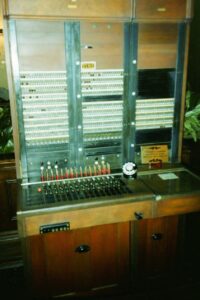 San Francisco, September 12, 1976: This is called a switchboard.
San Francisco, September 12, 1976: This is called a switchboard.
In Henrietta, Texas, in the upstairs (outside staircase, on the right) of the building at Bridge and Gilbert, on the corner of the courthouse square, was the phone company before dial phones were available. that was the phone company before the new building was built over by the Methodist Church, and before the time Mac McGilvray ran the phone company. [CLICK HERE TO SEE THAT BUILDING TODAY] In that upper floor were several switchboards, and that’s where the operator(s) were before the advent of dial-phones. You picked up the phone and asked Gladys to connect you to the Watson’s house.
After dial-phones, high school, and heading off to North Texas State University, I learned to operate a switchboard when I worked at Holiday Inn in Denton, and switchboards were still widely in use in the hotel/hospitality industry for inter-room and inside/outside calls for decades after that.
Years earlier, starting back east, the very first answering services had been created when some entrepreneurs obtained AT&T switchboards, and located themselves in a calling area (ie: near the “central office” where calls are switched, serving one particular neighborhood, identified by the prefix of the phone number. In Henrietta, I think it was Evergreen, but I’m not sure I’m remembering correctly, because San Francisco also had Evergreen exchange, north of Golden Gate Park.)
These first answering services worked like this: They had the phone company wire an extension of the business’s phone and the two wires were connected to ONE of the holes in the switchboard. In this way, when the business was closed, the calls were also “ringing” on the small red light beneath that hole. At the back of the console, shown above, you see the red objects which are plugs. You grab the left-side plug of any pair of plugs, shove it into the hole and now your headset (if you’re the operator) is live as you’ve just “answered” the call, like people at home do when they lift the receiver. Now the caller asks for the Watson’s house, or for room 117, and you plug the right-side plug of that pair into the Watson’s plug or room 117’s plug, and flip the small toggle switch in front of that pair of plugs. This rings the target phone at the Watson’s or room 117.
When the Watsons or room 117 answer, you flip the toggle another way, and you are removed from the conversation. You get another red light when the parties hang up.
All answering services around the country used switchboards to provide answering service to businesses right up until 1976 in San Francisco, when one day I got an advertisement falling out of my phone bill. It was for this new feature, “Call Forwarding.”
I was stoned at that moment and picked up the advertisement, and then said to myself. “I could use this to build an answering service, without the need for a switchboard.”
And … that’s what I did. The beginning of Network Answering Service.
A few years later, and 80% of the answering services in San Francisco had transitioned away from switchboards, to call-forwarding and new types of equipment.
That’s how it happened. Thank you, switchboards!


Leave a Reply